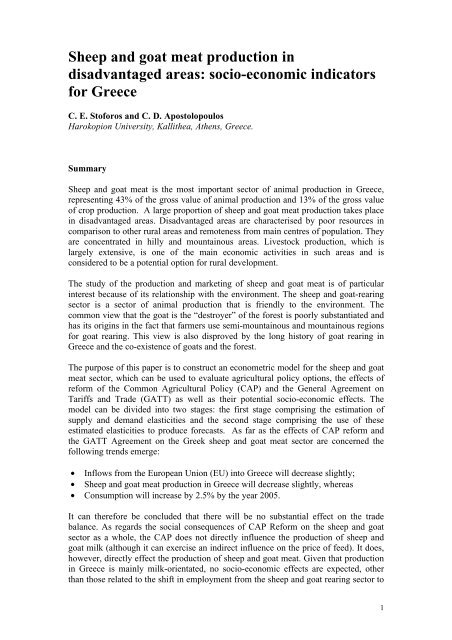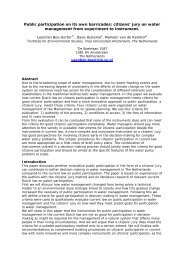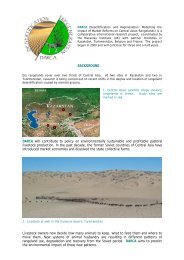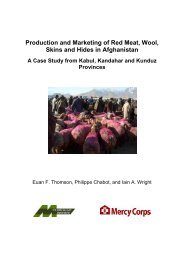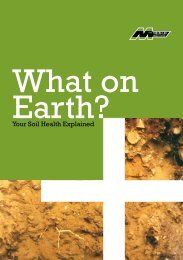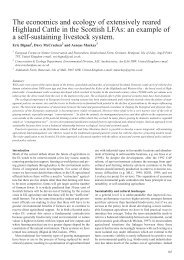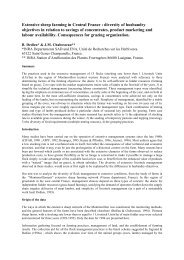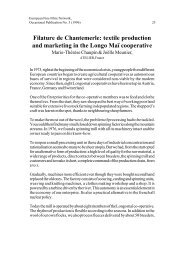Sheep and goat meat production in disadvantaged areas: socio ...
Sheep and goat meat production in disadvantaged areas: socio ...
Sheep and goat meat production in disadvantaged areas: socio ...
- No tags were found...
You also want an ePaper? Increase the reach of your titles
YUMPU automatically turns print PDFs into web optimized ePapers that Google loves.
<strong>Sheep</strong> <strong>and</strong> <strong>goat</strong> <strong>meat</strong> <strong>production</strong> <strong>in</strong><br />
<strong>disadvantaged</strong> <strong>areas</strong>: <strong>socio</strong>-economic <strong>in</strong>dicators<br />
for Greece<br />
C. E. Stoforos <strong>and</strong> C. D. Apostolopoulos<br />
Harokopion University, Kallithea, Athens, Greece.<br />
Summary<br />
<strong>Sheep</strong> <strong>and</strong> <strong>goat</strong> <strong>meat</strong> is the most important sector of animal <strong>production</strong> <strong>in</strong> Greece,<br />
represent<strong>in</strong>g 43% of the gross value of animal <strong>production</strong> <strong>and</strong> 13% of the gross value<br />
of crop <strong>production</strong>. A large proportion of sheep <strong>and</strong> <strong>goat</strong> <strong>meat</strong> <strong>production</strong> takes place<br />
<strong>in</strong> <strong>disadvantaged</strong> <strong>areas</strong>. Disadvantaged <strong>areas</strong> are characterised by poor resources <strong>in</strong><br />
comparison to other rural <strong>areas</strong> <strong>and</strong> remoteness from ma<strong>in</strong> centres of population. They<br />
are concentrated <strong>in</strong> hilly <strong>and</strong> mounta<strong>in</strong>ous <strong>areas</strong>. Livestock <strong>production</strong>, which is<br />
largely extensive, is one of the ma<strong>in</strong> economic activities <strong>in</strong> such <strong>areas</strong> <strong>and</strong> is<br />
considered to be a potential option for rural development.<br />
The study of the <strong>production</strong> <strong>and</strong> market<strong>in</strong>g of sheep <strong>and</strong> <strong>goat</strong> <strong>meat</strong> is of particular<br />
<strong>in</strong>terest because of its relationship with the environment. The sheep <strong>and</strong> <strong>goat</strong>-rear<strong>in</strong>g<br />
sector is a sector of animal <strong>production</strong> that is friendly to the environment. The<br />
common view that the <strong>goat</strong> is the “destroyer” of the forest is poorly substantiated <strong>and</strong><br />
has its orig<strong>in</strong>s <strong>in</strong> the fact that farmers use semi-mounta<strong>in</strong>ous <strong>and</strong> mounta<strong>in</strong>ous regions<br />
for <strong>goat</strong> rear<strong>in</strong>g. This view is also disproved by the long history of <strong>goat</strong> rear<strong>in</strong>g <strong>in</strong><br />
Greece <strong>and</strong> the co-existence of <strong>goat</strong>s <strong>and</strong> the forest.<br />
The purpose of this paper is to construct an econometric model for the sheep <strong>and</strong> <strong>goat</strong><br />
<strong>meat</strong> sector, which can be used to evaluate agricultural policy options, the effects of<br />
reform of the Common Agricultural Policy (CAP) <strong>and</strong> the General Agreement on<br />
Tariffs <strong>and</strong> Trade (GATT) as well as their potential <strong>socio</strong>-economic effects. The<br />
model can be divided <strong>in</strong>to two stages: the first stage compris<strong>in</strong>g the estimation of<br />
supply <strong>and</strong> dem<strong>and</strong> elasticities <strong>and</strong> the second stage compris<strong>in</strong>g the use of these<br />
estimated elasticities to produce forecasts. As far as the effects of CAP reform <strong>and</strong><br />
the GATT Agreement on the Greek sheep <strong>and</strong> <strong>goat</strong> <strong>meat</strong> sector are concerned the<br />
follow<strong>in</strong>g trends emerge:<br />
• Inflows from the European Union (EU) <strong>in</strong>to Greece will decrease slightly;<br />
• <strong>Sheep</strong> <strong>and</strong> <strong>goat</strong> <strong>meat</strong> <strong>production</strong> <strong>in</strong> Greece will decrease slightly, whereas<br />
• Consumption will <strong>in</strong>crease by 2.5% by the year 2005.<br />
It can therefore be concluded that there will be no substantial effect on the trade<br />
balance. As regards the social consequences of CAP Reform on the sheep <strong>and</strong> <strong>goat</strong><br />
sector as a whole, the CAP does not directly <strong>in</strong>fluence the <strong>production</strong> of sheep <strong>and</strong><br />
<strong>goat</strong> milk (although it can exercise an <strong>in</strong>direct <strong>in</strong>fluence on the price of feed). It does,<br />
however, directly effect the <strong>production</strong> of sheep <strong>and</strong> <strong>goat</strong> <strong>meat</strong>. Given that <strong>production</strong><br />
<strong>in</strong> Greece is ma<strong>in</strong>ly milk-orientated, no <strong>socio</strong>-economic effects are expected, other<br />
than those related to the shift <strong>in</strong> employment from the sheep <strong>and</strong> <strong>goat</strong> rear<strong>in</strong>g sector to<br />
1
other sectors of the economy, for example <strong>in</strong>to the primary sector or away from<br />
agriculture altogether. Given that a further decrease <strong>in</strong> agricultural population has<br />
been forecast it is anticipated that there will be some movement out of agriculture<br />
altogether.<br />
Introduction<br />
The sheep <strong>and</strong> <strong>goat</strong> <strong>meat</strong> sector is the most important sector of animal <strong>production</strong> <strong>in</strong><br />
Greece <strong>and</strong> represents 43% of the gross value of animal <strong>production</strong> <strong>and</strong> 13% of the<br />
gross value of crop <strong>production</strong>. The European Union produces 16% of the world's<br />
sheep <strong>and</strong> <strong>goat</strong> <strong>meat</strong>, which is ma<strong>in</strong>ly attributable to <strong>goat</strong> <strong>meat</strong> <strong>production</strong>. S<strong>in</strong>ce<br />
1981 a common organisation of the market (CMO) <strong>in</strong> sheep <strong>and</strong> <strong>goat</strong> <strong>meat</strong> has been <strong>in</strong><br />
force. The CMO is established <strong>in</strong> Council Regulation 3013/89, as amended by<br />
Council Regulation 2062/92.<br />
A large proportion of sheep <strong>and</strong> <strong>goat</strong> <strong>meat</strong> <strong>production</strong> takes place <strong>in</strong> <strong>disadvantaged</strong><br />
<strong>areas</strong>. Disadvantaged <strong>areas</strong> are characterised by hav<strong>in</strong>g poor resources <strong>in</strong> comparison<br />
to other rural <strong>areas</strong> <strong>and</strong> remoteness from ma<strong>in</strong> centres of population. They are also<br />
concentrated <strong>in</strong> hilly <strong>and</strong> mounta<strong>in</strong>ous <strong>areas</strong> (Apostolopoulos <strong>and</strong> Mergos, 1997).<br />
They suffer strong depopulation, economic decl<strong>in</strong>e <strong>and</strong> a deteriorat<strong>in</strong>g social fabric.<br />
Livestock <strong>production</strong>, which is largely extensive, is one of the ma<strong>in</strong> economic<br />
activities <strong>in</strong> such <strong>areas</strong> <strong>and</strong> is considered to be an option for potential development.<br />
Increas<strong>in</strong>g productivity <strong>and</strong> efficiency are the ma<strong>in</strong> strategic objectives for achiev<strong>in</strong>g<br />
susta<strong>in</strong>able development <strong>and</strong> for revers<strong>in</strong>g the trend of decl<strong>in</strong>e <strong>in</strong> <strong>disadvantaged</strong> <strong>areas</strong>.<br />
Increas<strong>in</strong>g productivity <strong>and</strong> efficiency of livestock systems can be achieved by:<br />
• Increas<strong>in</strong>g the technology of <strong>production</strong><br />
• Reduc<strong>in</strong>g labour requirements<br />
• Reduc<strong>in</strong>g distance costs by improv<strong>in</strong>g transportation, communication <strong>and</strong><br />
market<strong>in</strong>g channels <strong>and</strong><br />
• Encourag<strong>in</strong>g the development of local <strong>in</strong>itiatives for address<strong>in</strong>g issues such as<br />
the management of common property resources, tra<strong>in</strong><strong>in</strong>g, <strong>and</strong> f<strong>in</strong>ancial<br />
constra<strong>in</strong>ts.<br />
Dur<strong>in</strong>g the past decade there has been great dem<strong>and</strong> for quantitative analysis of the<br />
effects of agricultural policy measures, <strong>in</strong> particular effects on world trade <strong>in</strong><br />
agricultural products. Dur<strong>in</strong>g the General Agreement on Tariffs <strong>and</strong> Trade (GATT)<br />
negotiations, many efforts were made to evaluate the effect on world markets <strong>and</strong><br />
world economic prosperity of state <strong>in</strong>tervention to support agricultural prices <strong>in</strong> the<br />
EU <strong>and</strong> <strong>in</strong> other countries or groups of countries. No such quantitative evaluation<br />
exists of the impact of the GATT Agreement on Greece.<br />
The methodology followed <strong>in</strong> this paper has also been used <strong>in</strong> a number of studies,<br />
which analyse the effects of trade liberalisation (Ron<strong>in</strong>gen et al., 1991, Tyers <strong>and</strong><br />
Anderson, 1992). The analysis is divided <strong>in</strong>to two stages: the first stage compris<strong>in</strong>g<br />
the estimation of supply <strong>and</strong> dem<strong>and</strong> elasticities <strong>and</strong> the second stage compris<strong>in</strong>g the<br />
use of these estimated elasticities to produce forecasts.<br />
The ma<strong>in</strong> aim of this paper is to create a partial equilibrium model for the sheep <strong>and</strong><br />
<strong>goat</strong> <strong>meat</strong> sector <strong>in</strong> Greece for the purposes of simulat<strong>in</strong>g policy choices <strong>and</strong><br />
discuss<strong>in</strong>g their potential impacts on forests (forest <strong>and</strong> <strong>goat</strong> rear<strong>in</strong>g sector) <strong>and</strong> the<br />
2
<strong>socio</strong>-economic environment. The construction of a sector model for policy analysis is<br />
considered both useful <strong>and</strong> essential, particularly for Greece. Sector modell<strong>in</strong>g is of<br />
vital importance for Greece as so far none has been undertaken <strong>and</strong> both CAP Reform<br />
<strong>and</strong> the GATT Agreement will have profound impacts on the structure, <strong>production</strong>,<br />
<strong>and</strong> <strong>in</strong>come of Greek farms.<br />
The theoretical model<br />
The logic of the present model is fairly simple (Mergos, 1988; Mergos <strong>and</strong> Stoforos,<br />
1994; Stoforos, 1997). In this model prices are determ<strong>in</strong>ed by two exogenous factors:<br />
the world market <strong>and</strong> the government. These prices <strong>in</strong> turn determ<strong>in</strong>e the dem<strong>and</strong> <strong>and</strong><br />
supply of sheep <strong>and</strong> <strong>goat</strong> <strong>meat</strong>. Trade is the equilibrat<strong>in</strong>g mechanism for balanc<strong>in</strong>g<br />
dem<strong>and</strong> <strong>and</strong> supply for sheep <strong>and</strong> <strong>goat</strong> <strong>meat</strong> given a certa<strong>in</strong> set of prices.<br />
The model is based on two key assumptions <strong>and</strong> simplifications. The first is that all<br />
prices are exogenous, determ<strong>in</strong>ed by the government <strong>and</strong> the world market. The<br />
second assumption is that any imbalance between domestic dem<strong>and</strong> <strong>and</strong> supply will<br />
result <strong>in</strong> trade. In fact, it is only <strong>in</strong>centives for trade, which are created <strong>and</strong> these may<br />
or may not be fulfilled. These <strong>in</strong>centives may be constra<strong>in</strong>ed by government<br />
<strong>in</strong>tervention <strong>in</strong> the form of quotas, tariffs, etc. or simply lack of foreign currency.<br />
This model is flexible enough to accommodate government policies (albeit rather<br />
crudely) that affect both the direction <strong>and</strong> volume of trade. An important characteristic<br />
of the model is that it <strong>in</strong>corporates dynamics <strong>in</strong> supply response. Dem<strong>and</strong> is modelled<br />
as per capita dem<strong>and</strong> <strong>and</strong> is specified as be<strong>in</strong>g a function of prices <strong>and</strong> <strong>in</strong>come.<br />
Multiplication of per capita dem<strong>and</strong> by population gives total retail dem<strong>and</strong>.<br />
The model simulates the impact of changes <strong>in</strong> a set of variables <strong>and</strong> changes <strong>in</strong><br />
government policies on a set of endogenous variables. The model starts from a base<br />
year <strong>and</strong> then predicts the changes that will result from the implementation of<br />
different scenarios. The core of the model consists of two elasticity matrices, a matrix<br />
of dem<strong>and</strong> elasticities <strong>and</strong> a matrix of supply elasticities (Tables 1 <strong>and</strong> 2). The model<br />
explicitly recognises the relationship between dem<strong>and</strong> or supply <strong>and</strong> price changes<br />
(Stoforos <strong>and</strong> Apostolopoulos, 1997).<br />
The dem<strong>and</strong> function may be written as:<br />
lnQ D = A+ BlnP+ ClnI (Equation 1)<br />
where, Q D = the vector of commodity dem<strong>and</strong>ed for each commodity, A = the vector<br />
of the constant parameters for each equation, B = the symmetrical matrix of dem<strong>and</strong><br />
elasticities, P = the vector of retail price for each commodity, C = the vector of the<br />
<strong>in</strong>come elasticities of dem<strong>and</strong> <strong>and</strong> I = the matrix of <strong>in</strong>come.<br />
Total output (= Q of any product) is given by the product of number of animals<br />
(= A) <strong>and</strong> yield (= Y). Thus we have, QP = A * Y, where, QP = vector of quantities<br />
produced, A = vector of number of animals, Y = vector of yield. The functions for<br />
number of animals (= A) <strong>and</strong> yield (= Y) are:<br />
A t = F (A t-1 , P t-n , Z A ) (Equation 2)<br />
3
where (Equation 2) is estimated us<strong>in</strong>g econometric methods, as mentioned above, <strong>in</strong><br />
its logarithmic form <strong>and</strong>, P is the vector of prices, Z A are other variables.<br />
Y t = H (Y t-1 , P t-n , Z B ) (Equation 3)<br />
where (Equation 3) is also estimated us<strong>in</strong>g econometric methods <strong>in</strong> its logarithmic<br />
form <strong>and</strong>, P is the vector of prices <strong>and</strong> Z B are other variables (i.e. trend etc.).<br />
Table 1.<br />
Supply elasticities<br />
Products Short-term Long-term<br />
<strong>Sheep</strong> <strong>meat</strong>:<br />
Number of animals 0.04 0.08<br />
Yield 0.03 0.06<br />
Goat <strong>meat</strong><br />
Number of animals 0.03 0.06<br />
Yield 0.03 0.05<br />
Source: Apostolopoulos <strong>and</strong> Stoforos, 1996.<br />
Table 2.<br />
Dem<strong>and</strong> elasticities<br />
Products Price Income<br />
<strong>Sheep</strong> <strong>meat</strong> -0.55 0.55<br />
Goat <strong>meat</strong> -0.50 0.50<br />
Source: Baltas, 1990 p.76.<br />
Production of commodities depends on number of animals <strong>and</strong> average yield response<br />
(equations 2 <strong>and</strong> 3). Domestic supply is the sum of <strong>production</strong> <strong>and</strong> start<strong>in</strong>g stocks.<br />
Trade is usually calculated as the difference between total dem<strong>and</strong> <strong>and</strong> domestic<br />
supply, imply<strong>in</strong>g that the government will import what is needed <strong>and</strong> export what is<br />
surplus. Total supply is equal to domestic supply plus imports. Per capita<br />
consumption is <strong>in</strong>fluenced by changes <strong>in</strong> price <strong>and</strong> <strong>in</strong>come. Total food consumption<br />
is determ<strong>in</strong>ed by multiply<strong>in</strong>g population <strong>and</strong> per capita consumption. Industrial <strong>and</strong><br />
other uses are def<strong>in</strong>ed as a fixed proportion of <strong>production</strong> or consumption, depend<strong>in</strong>g<br />
upon the product. Domestic dem<strong>and</strong> is the sum of total dem<strong>and</strong> for food, <strong>in</strong>dustrial<br />
<strong>and</strong> other uses <strong>and</strong> end stocks. In addition to the supply <strong>and</strong> dem<strong>and</strong> components,<br />
aggregate measures are also <strong>in</strong>cluded for per capita consumption, expenditure <strong>and</strong><br />
self-sufficiency ratios.<br />
It is assumed that producers have fixed <strong>in</strong>puts <strong>and</strong> that they allocate these <strong>in</strong>puts to<br />
alternative enterprises on the basis of relative product prices. It is assumed that<br />
consumers also allocate <strong>in</strong>come to alternative goods on the basis of the relative prices<br />
of goods. The present <strong>production</strong> <strong>and</strong> consumption structure therefore provides the<br />
conditions of the status quo. This <strong>production</strong> <strong>and</strong> consumption pattern will change<br />
over time, primarily <strong>in</strong> response to price, <strong>in</strong>come, <strong>in</strong>flation <strong>and</strong> exchange rate changes.<br />
Implementation of the model beg<strong>in</strong>s with data collection. Given the structure of the<br />
model, described <strong>in</strong> previous paragraphs, the follow<strong>in</strong>g data is required <strong>in</strong> order to<br />
implement the model: 1) Population <strong>and</strong> Income, 2) Dem<strong>and</strong> <strong>and</strong> Supply Elasticities,<br />
4
3) The quantities of different products produced, 4) Domestic Prices, 5) World Market<br />
Prices, 6) Taxes <strong>and</strong> Subsidies, 7) Cost of <strong>production</strong> Inputs, 8) Number of Animals.<br />
CAP <strong>and</strong> the sheep <strong>and</strong> <strong>goat</strong> <strong>meat</strong> sector<br />
In order to proceed <strong>and</strong> elaborate a statistical model for the Greek sheep <strong>and</strong> <strong>goat</strong><br />
<strong>meat</strong> sector, it is important to consider some of the policy implications, which resulted<br />
from the 1992 CAP Reform. This analysis is of vital importance, s<strong>in</strong>ce there is a<br />
direct relationship between the estimated elasticities <strong>and</strong> the effectiveness of various<br />
policy measures. As mentioned <strong>in</strong> the <strong>in</strong>troduction, an analysis of supply response is<br />
crucial to underst<strong>and</strong><strong>in</strong>g the effects of government <strong>in</strong>tervention. Therefore, estimat<strong>in</strong>g<br />
the elasticity of supply relative to prices is a fundamental prerequisite for estimat<strong>in</strong>g<br />
the effects of the CAP on Greek producers.<br />
The May 1992 Council of M<strong>in</strong>isters Agreement to reform the CAP conta<strong>in</strong>ed several<br />
departures from previous EU policies. The reforms <strong>in</strong>volved drastic reductions <strong>in</strong><br />
support for sheep <strong>meat</strong>, with no compensation, whilst mild reforms <strong>in</strong> support for the<br />
milk <strong>and</strong> beef sectors were largely the result of reforms <strong>in</strong> the cereals <strong>and</strong> oilseed<br />
sectors.<br />
Each year the Council fixes a basic price (the same throughout the EU) which is used<br />
for calculat<strong>in</strong>g the ewe premium. To take account of seasonal variations <strong>in</strong> the<br />
market, this price is seasonally adjusted. In order to ensure a fair st<strong>and</strong>ard of liv<strong>in</strong>g<br />
for farmers <strong>and</strong> to stabilise markets, a premium was granted to compensate farmers<br />
for their loss of <strong>in</strong>come. Before the 1989 Reform, the Community was divided <strong>in</strong>to<br />
seven regions. At the end of the market<strong>in</strong>g year, the <strong>in</strong>come loss was estimated for<br />
each region on the basis of the market prices recorded dur<strong>in</strong>g that year. This <strong>in</strong>come<br />
loss was calculated as be<strong>in</strong>g the difference between the basic price <strong>and</strong> the arithmetic<br />
mean of market prices recorded dur<strong>in</strong>g the year. The amount of <strong>in</strong>come lost then<br />
formed a basis on which to calculate the amount of ewe premium payable <strong>in</strong> each of<br />
the seven regions.<br />
A Community quality st<strong>and</strong>ard was established based on the widespread <strong>production</strong> of<br />
specialised flocks. A dist<strong>in</strong>ction is made between light-lamb <strong>and</strong> heavy-lamb<br />
producers, all producers of sheep milk be<strong>in</strong>g classed as light-lamb producers, unless<br />
proven otherwise. The loss of <strong>in</strong>come to producers is the difference between the basic<br />
price <strong>and</strong> the arithmetic mean of market prices recorded dur<strong>in</strong>g the market<strong>in</strong>g year.<br />
The amount of premium paid is determ<strong>in</strong>ed by apply<strong>in</strong>g a technical coefficient for<br />
"heavy lambs" or, 80% of this rate for "light lambs" to the loss of <strong>in</strong>come. The full<br />
premium is paid for up to: i) 1000 animals per producer <strong>in</strong> less-favoured <strong>areas</strong>, ii) 500<br />
animals per producer <strong>in</strong> other <strong>areas</strong>. Above these limits, the premium is reduced by<br />
50%. S<strong>in</strong>ce the 1991 market<strong>in</strong>g year, an additional premium of 4 ECU per ewe has<br />
been paid as part of the rural development measures for hill <strong>and</strong> mounta<strong>in</strong> farms <strong>and</strong><br />
farms <strong>in</strong> other less favoured <strong>areas</strong>. This aid was <strong>in</strong>creased to 5.5 ECU for the 1992<br />
market<strong>in</strong>g year. Import arrangements differ accord<strong>in</strong>g to the products imported.<br />
Estimated results<br />
In order to test the accuracy of the model <strong>and</strong> its ability to take account of changes <strong>in</strong><br />
the economic environment an historical simulation was carried out. This means that<br />
the model's predictions for the years 1990-92 were compared to actual results. The<br />
5
esults of this simulation can be considered a success, given that the difference<br />
between the model's prediction prices <strong>and</strong> actual prices was 0-2%. Verify<strong>in</strong>g the<br />
model aga<strong>in</strong>st an historical example is essential as unless the model can reproduce<br />
known results its forecasts, where actual results cannot be known, will not be<br />
satisfactory.<br />
In order to analyse the effects of CAP Reform <strong>and</strong> the GATT Agreement, the<br />
follow<strong>in</strong>g scenario was used: <strong>in</strong> the first stage, the world market price of sheep <strong>and</strong><br />
<strong>goat</strong> <strong>meat</strong> for the period 1986-1988 was calculated. In order to calculate the world<br />
market price the volume <strong>and</strong> value of imports <strong>and</strong> exports were used, tak<strong>in</strong>g <strong>in</strong>to<br />
account the (1986-1988) tariff equivalent, as well as the reduction <strong>in</strong> this tariff<br />
equivalent which will take place over the next six years (1995-2000/1), as shown <strong>in</strong><br />
the follow<strong>in</strong>g equation:<br />
P i<br />
= P d + x + y (Equation 4)<br />
where P i is the predicted price for the year i , P d the world market price, x the tariff<br />
equivalent <strong>and</strong> y the policy followed after CAP Reform. In this way it is possible to<br />
estimate the world market price for sheep <strong>and</strong> <strong>goat</strong> <strong>meat</strong> (Table 3). In addition it was<br />
also possible us<strong>in</strong>g equation 4 to calculate <strong>in</strong>flows <strong>in</strong>to Greece from the rest of the<br />
EU. The results are presented <strong>in</strong> Tables 4-6. Inflows <strong>in</strong>to Greece from the rest of the<br />
EU were calculated us<strong>in</strong>g data from the M<strong>in</strong>istry of Agriculture.<br />
Table 3.<br />
World prices, tariff equivalents <strong>and</strong> Common Agricultural Policy<br />
(1) (2) (3) (4) (5) (6)<br />
World<br />
Price<br />
ECU/t<br />
(86-88)<br />
Tariff<br />
Equivalent<br />
ECU/t<br />
(86-88)<br />
Tariff<br />
Equivalent<br />
ECU/t<br />
(2000/1)<br />
Policy (CAP) Prices<br />
1995/96<br />
ECU/t<br />
% Change<br />
<strong>in</strong> prices<br />
(1996-<br />
2000/1)<br />
Barley 85 145 93 54.34 ECU/t* Historic Yield 173.53 -15%<br />
Maize 95 147 94 54.34 ECU/t* Historic Yield 173.53 -15%<br />
Other<br />
95 147 94 54.34 ECU/t* Historic Yield 173.53 -15%<br />
cereals<br />
<strong>Sheep</strong> <strong>and</strong><br />
<strong>goat</strong> <strong>meat</strong><br />
142 2013 1288 5040.7ECU/t+26.046<br />
(subsidy for heavy/head) <strong>and</strong><br />
5040.7+20.83(subsidy for<br />
light/head)<br />
5066.8 -20%<br />
Sources: (1), (2), (3) Sarris et al. (1996), (4) Greek M<strong>in</strong>istry of Agriculture <strong>and</strong> European<br />
Commission (1993), (5) Greek M<strong>in</strong>istry of Agriculture, (6) Assumptions of the model.<br />
Table 4.<br />
Predicted sheep <strong>and</strong> <strong>goat</strong> <strong>meat</strong> <strong>production</strong>, consumption <strong>and</strong><br />
trade (000 tonnes)<br />
Year Production Consumption Trade<br />
1993 155 145 10<br />
2000 150 147 3<br />
2005 148 148 0<br />
6
Table 5.<br />
Predicted self-sufficiency ratio <strong>in</strong> sheep <strong>and</strong> <strong>goat</strong> <strong>meat</strong><br />
Year 1993 1994 1995 1998 1999 2000 2003 2005<br />
1.07 1.06 1.06 1.04 1.03 1.02 1.02 1.00<br />
Table 6.<br />
Predicted imports of sheep <strong>and</strong> <strong>goat</strong> <strong>meat</strong> <strong>in</strong>to Greece from the<br />
rest of the EU (ECU's)<br />
Year 1993 2000 2005<br />
240 879 305 235 123 931 235 123 931<br />
Conclusions<br />
The purpose of this paper is to describe the construction of a model for the sheep <strong>and</strong><br />
<strong>goat</strong> <strong>meat</strong> sector that would contribute to the evaluation of agricultural policy<br />
measures, to the <strong>socio</strong>-economic analysis of the sector <strong>and</strong> to the discussion of<br />
environmental issues, concern<strong>in</strong>g predom<strong>in</strong>antly the <strong>goat</strong>-rear<strong>in</strong>g sector. The<br />
methodology used is based on previously applied econometric methods as well as the<br />
simulation method. Accord<strong>in</strong>g to the model the effects of CAP Reform <strong>and</strong> the GATT<br />
Agreement will be the follow<strong>in</strong>g: 1) Inflows from the EU to Greece are expected to<br />
show a slight decrease due to a predicted reduction <strong>in</strong> domestic sheep <strong>and</strong> <strong>goat</strong> <strong>meat</strong><br />
<strong>production</strong>, 2) The <strong>production</strong> of sheep <strong>and</strong> <strong>goat</strong> <strong>meat</strong> will also decrease slightly as a<br />
result of predicted price reductions. The consumption of sheep <strong>and</strong> <strong>goat</strong> <strong>meat</strong> is<br />
expected to <strong>in</strong>crease by 2.5% to the year 2005, with the reduction <strong>in</strong> price pr<strong>in</strong>cipally<br />
be<strong>in</strong>g the result of consumer patterns. Given this, effects on the balance of trade are<br />
negligible.<br />
Inflows from the rest of the EU to Greece are expected to decrease slightly due to a<br />
predicted decrease <strong>in</strong> domestic sheep <strong>and</strong> <strong>goat</strong> <strong>meat</strong> <strong>production</strong>. It is also predicted<br />
that under the Common Market Organisation there will be an improvement <strong>in</strong> the<br />
quality of slaughter houses for sheep <strong>and</strong> <strong>goat</strong> <strong>meat</strong> at a national level (quality<br />
controls, etc.).<br />
The <strong>production</strong> of sheep <strong>and</strong> <strong>goat</strong> <strong>meat</strong> is expected to decrease slightly as a result of<br />
price reductions. Despite the fact that the fall <strong>in</strong> the price of sheep <strong>and</strong> <strong>goat</strong> <strong>meat</strong> is<br />
expected to be considerable, <strong>production</strong> will decrease only slightly. The reason beh<strong>in</strong>d<br />
this is the need to ma<strong>in</strong>ta<strong>in</strong> the sector for the <strong>production</strong> of sheep <strong>and</strong> <strong>goat</strong> milk <strong>and</strong><br />
traditional milk products such as cheese <strong>and</strong> yoghurt. The sheep <strong>and</strong> <strong>goat</strong> sector <strong>in</strong><br />
Greece is traditionally based more on milk than <strong>meat</strong> <strong>production</strong>. This expla<strong>in</strong>s the<br />
differences <strong>in</strong> the decrease of prices <strong>and</strong> <strong>production</strong> predicted over the next decade.<br />
The EU divides sheep <strong>and</strong> <strong>goat</strong> <strong>meat</strong> producers <strong>in</strong>to two categories (depend<strong>in</strong>g on the<br />
type of <strong>production</strong> concerned). The first category consists of producers of sheep milk<br />
<strong>and</strong> sheep milk products, who are termed “light” sheep producers. This category also<br />
<strong>in</strong>cludes all <strong>goat</strong> producers. The second category consists of all other sheep <strong>meat</strong><br />
producers, who are termed “heavy” sheep producers. Greece belongs to the first<br />
category; it rears 10% of the EU's sheep <strong>and</strong> approximately 40% of the <strong>goat</strong>s. Greece<br />
7
also uses 95% of its sheep for the <strong>production</strong> of milk, compared to 30% <strong>in</strong> the EU as a<br />
whole.<br />
The supply elasticity for sheep <strong>and</strong> <strong>goat</strong> <strong>meat</strong> is very low, which means that Greek<br />
sheep <strong>and</strong> <strong>goat</strong> <strong>meat</strong> producers are not so much <strong>in</strong>fluenced by changes <strong>in</strong> the price of<br />
their product as <strong>in</strong> factors related to the stability of their family <strong>in</strong>come i.e. risk<br />
m<strong>in</strong>imisation.<br />
As regards the social consequences of CAP Reform on the sheep <strong>and</strong> <strong>goat</strong> sector as a<br />
whole, the CAP does not directly <strong>in</strong>fluence the <strong>production</strong> of sheep <strong>and</strong> <strong>goat</strong> milk<br />
(although it can exercise an <strong>in</strong>direct <strong>in</strong>fluence on the price of feed). It does, however,<br />
directly effect the <strong>production</strong> of sheep <strong>and</strong> <strong>goat</strong> <strong>meat</strong>. Given that <strong>production</strong> <strong>in</strong> Greece<br />
is ma<strong>in</strong>ly milk orientated, no <strong>socio</strong>-economic effects are expected, other than those<br />
related to the shift <strong>in</strong> employment from the sheep <strong>and</strong> <strong>goat</strong> rear<strong>in</strong>g sector to other<br />
sectors of the economy, for example <strong>in</strong>to the primary sector or away from agriculture<br />
altogether. Given that a further decrease <strong>in</strong> agricultural population has been forecast it<br />
is anticipated that there will be some movement out of agriculture altogether. It is<br />
possible that an <strong>in</strong>crease <strong>in</strong> the number of animals as well as an <strong>in</strong>crease <strong>in</strong><br />
productivity will contribute to a move away from traditional family farms <strong>and</strong> towards<br />
more <strong>in</strong>tensive <strong>production</strong>. Although it is, perhaps, too early to draw this type of<br />
<strong>socio</strong>-economic conclusion.<br />
The consumption of sheep <strong>and</strong> <strong>goat</strong> <strong>meat</strong> is expected to <strong>in</strong>crease by just 2.5% by the<br />
year 2005 despite a considerable decrease <strong>in</strong> the price, a fact that is primarily related<br />
to consumption patterns. In Greece as <strong>in</strong> many other countries there has been an<br />
important shift towards the consumption of white <strong>meat</strong> over the last few years.<br />
The sheep <strong>and</strong> <strong>goat</strong> sector is a sector of animal <strong>production</strong> that is friendly to the<br />
environment. The common view that the <strong>goat</strong> is the “destroyer” of the forest is poorly<br />
substantiated <strong>and</strong> has its orig<strong>in</strong>s <strong>in</strong> the fact that farmers use semi-mounta<strong>in</strong>ous <strong>and</strong><br />
mounta<strong>in</strong>ous regions for <strong>goat</strong> rear<strong>in</strong>g. This view is also disproved by the long history<br />
of <strong>goat</strong> rear<strong>in</strong>g <strong>in</strong> Greece <strong>and</strong> the co-existence of <strong>goat</strong>s <strong>and</strong> the forest. Accord<strong>in</strong>g to<br />
the model used <strong>in</strong> this paper, the number of sheep <strong>and</strong> <strong>goat</strong>s <strong>in</strong> Greece will only<br />
<strong>in</strong>crease slightly as a result of CAP Reform <strong>and</strong> therefore the current equilibrium<br />
between the <strong>goat</strong> <strong>and</strong> the forest will be ma<strong>in</strong>ta<strong>in</strong>ed.<br />
8
References<br />
Apostolopoulos, D.C. <strong>and</strong> Mergos, G., 1997. "Economic constra<strong>in</strong>ts on the<br />
development of livestock <strong>production</strong> systems <strong>in</strong> <strong>disadvantaged</strong> <strong>areas</strong>". In: Livestock<br />
systems <strong>in</strong> European rural development (eds. J.P. Laker <strong>and</strong> J.A. Milne). Proceed<strong>in</strong>gs<br />
of the first Conference of the LSIRD Network, Nafplio, Greece. Macaulay L<strong>and</strong> Use<br />
Research Institute. pp19-24.<br />
Apostolopoulos, D.C. <strong>and</strong> Stoforos, E. C., 1997. Disaggregate <strong>meat</strong> supply response:<br />
a co-<strong>in</strong>tegration analysis for the Greek livestock sector, Spoudai (<strong>in</strong> press).<br />
Baltas, N.C., 1990. Consequences of the readjustment of the green exchange rate of<br />
the Drachma, (<strong>in</strong> Greek) Sakkoulas publications, Athens.<br />
Mergos, G.J., 1988. Agricultural policy spreadsheet simulator: a program for tra<strong>in</strong><strong>in</strong>g<br />
<strong>in</strong> agricultural policy analysis, mimeo graph FAO/ESP/Tra<strong>in</strong><strong>in</strong>g Division.<br />
Mergos, G.J. <strong>and</strong> Stoforos, C.E., 1994. APAS: Agricultural policy analysis simulator.<br />
Paper presented at the 3rd conference of the Greek Agricultural Economics Society<br />
(<strong>in</strong> Greek), Athens.<br />
Ron<strong>in</strong>gen, V.O., Sullivan, J. <strong>and</strong> Dixit, P.M., 1991. Documentation of the static<br />
world policy simulation (SWOPSIM) modell<strong>in</strong>g framework. Agriculture <strong>and</strong> Trade<br />
Analysis Division, Economic Research Service, US Department of Agriculture, Staff<br />
Report no. AGES 9151.<br />
Sarris, A.H., Mergos, G. <strong>and</strong> Sarros, G., 1996. The Uruguay Round Agreement for<br />
International Trade <strong>and</strong> its effects on Greek agriculture. (In Greek) Foundation of<br />
Economic <strong>and</strong> Industrial Research, Athens.<br />
Stoforos, C.E., 1997. Agricultural sector modell<strong>in</strong>g for policy analysis: the case of<br />
Greece, unpublished PhD thesis, University of Read<strong>in</strong>g, UK.<br />
Stoforos, C.E. <strong>and</strong> Apostolopoulos, D.C., 1997. Production, consumption <strong>and</strong> trade of<br />
sheep <strong>and</strong> <strong>goat</strong> <strong>meat</strong> <strong>in</strong> Greece, for the period 1996-2005. Medit, No. 3.<br />
Tyers, R. <strong>and</strong> Anderson, K., 1992. Disarray <strong>in</strong> world food markets, Cambridge<br />
University Press, Australia.<br />
9


